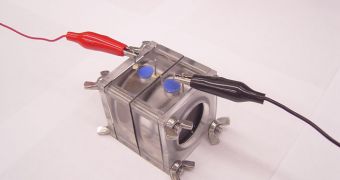While some groups of scientists are still struggling to develop the highly efficient hydrogen fuel cells they have promised some decades ago, others are slowly moving towards alternative solutions that would not only burn fuel, but would also clear toxic waste messes created during mining operations, and could produce electricity in much the same way as the traditional fuel cells.
The new idea involves using contaminated water, with high amounts of heavy metals that can seep all the way through the layers of earth to the underground water deposits, contaminating them as well. Most of the times such toxic water eliminated in industrial process contains metals, like arsenic or lead of iron, that are relatively difficult and expensive to filter out.
In the hope that they would succeed in attacking two problems at the same time, meaning the water decontamination process and creating an alternative source of electric energy, engineers from the Pennsylvania State University developed a prototype that uses waste water contaminated with iron. The prototype is able to extract the iron suspensions from the fluid, by removing part of the electrons from the metal that are turned into electric energy, which also makes the iron insoluble in liquid solutions thus removing it in an extremely efficient way.
According to the inventors, the iron deposited in the device could then be recycled in order to create pigments for paints, or other alternative applications. However, the biggest advantage of such a device is that it could not only be used to extract iron from solutions, albeit theoretically it could work with multiple aqueous solutions contaminated with different heavy metals, such as arsenic of other solvable metals that present increased poisoning risk for people, plants and animals.
Nevertheless, it seems that while trying to expand our list containing alternative electric energy producing device, we've always hit the age old problem of efficiency. The new prototype is rather efficient at extracting the soluble metals from the aqueous solutions; however, during this process it produces an extremely small amount of electricity. Bruce Logan, one of the researchers of the design team that created the new device, estimates that a fuel cell having a size comparable to that of a refrigerator would probably produce enough energy to power a small incandescent light bulb. The team is currently working on improving the design, in the hope that they will be able to create a device with an increased power output.

 14 DAY TRIAL //
14 DAY TRIAL //